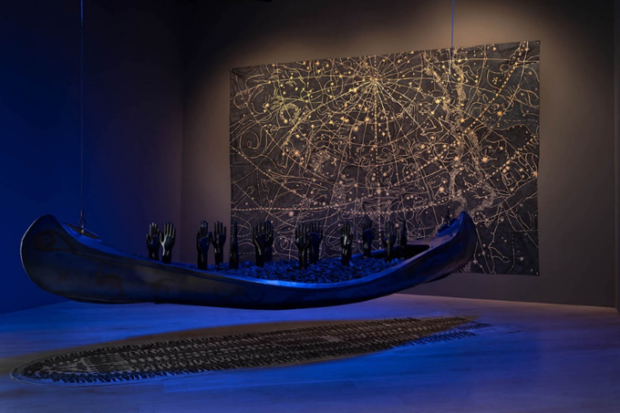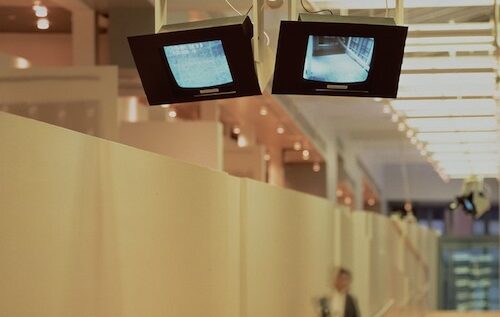
1 of 9 plates, 30 x 42 cm each. Via The Atlas Group: http://www.atlasgroup.org/
My internal conversation with the work of Walid Raad began as I paged my way through a monograph of his work, entitled Scratching on Things I Could Disavow: Some Essays from The Atlas Group Project (Cologne: Walther König, 2008), before the artist’s recent lecture at the Institute of Fine Arts on February 23, 2012. A Lebanese-born artist and associate professor at The Cooper Union, Raad is perhaps best known for his work under the guise of The Atlas Group, a fictional collective founded to examine the political, social, and psychological effects of Lebanon’s Civil War through archival documentation.
This archival documentation takes on a variety of forms, ranging from photographs of Raad’s personal collection of bullets, found during his teenage years in Beirut, to reproductions of documents attributed to (fictional) figures like Dr. Fadl Faukhouri, a leading historian of the Civil War until his death in 1993. The assembled contributions of Dr. Faukhouri and others seem to treat the war somewhat objectively by focusing on minute details and empirical data. In actuality, however, they suggest both the extreme psychological effects of the war upon the Lebanese people and the concomitant difficulty of portraying this people’s experience of war. For example, notebooks in The Atlas Group archive that belonged to Dr. Faukhouri show that the historian would obsessively walk the streets of Beirut in search of intact versions of models of cars recently destroyed by car bombs. He would then photograph his finds, to document the frequency with which certain makes and models were used in these bombings.
The aforementioned monograph, Scratching on Things I Could Disavow, published on the occasion of the exhibition The Atlas Group (1989-2004): A Project by Walid Raad at Culturgest in Lisbon, contains reproductions of articles, interviews, and documents that relate to Raad’s work and to the archive formed by The Atlas Group. Following Raad’s practice of exhibiting photographs of documents and objects, rather than the documents and objects themselves, the book comprises a series of overhead scans of papers, magazines, and articles. Each is related to Raad’s oeuvre in some way, although his role in their authorship is not always immediately clear. Even when he explicitly states that the Group is an imaginary foundation, as he does often in exhibitions and lectures, he notes that his audience sometimes fails to grasp the “imaginary nature” of the Group and its documents.[1] For Raad, “this confirms to me the weighty associations with authority and authenticity of certain modes of address (the lecture, the conference) and display (the white walls of a museum or gallery, vinyl text, the picture frame), modes that I choose to lean on and play with at the same time.”[2] I would add to this list of confusingly authoritative documents the monograph he has published.
Raad’s remark sets the stage for my comments on his recent lecture at the IFA, “Scratching on Things I Could Disavow.” When looking over his work in books, I too thought about how his audience of gallery-goers or readers, in the absence of the artist’s person, might be able to differentiate between the historical world and the imaginary characters conceived by Raad and informed by his archival research. Hussein Mehdi (a “real” person?) describes Raad’s documents as fitting into three categories: “Type A (authored), Type FD (found), and Type AGP (Atlas Group Productions).”[3] I wondered how Raad would navigate these categories in his IFA lecture—whether he might let his audience know which portions of his talk fit into each category. Furthermore, I wondered, how would the experience of various types of his work differ according to the format in which the viewer encounters it: lecture by the artist, wall of a gallery, or page of a book?
Raad structured his talk in four sections, each devoted to a fragment he thought significant to his ongoing project, which he began in 2007 and titled “Scratching on Things I Could Disavow: A History of Modern and Contemporary Art in the Arab World.” This project expands upon the work initiated by The Atlas Group in its continued documentation of the history of Lebanon and its play with notions of authority/authorship and the construction of history. In this specific project, however, Raad turns his attention to the history of art. Extremely timely in his call to record the history of modern and contemporary art in the Arab world, as it increasingly becomes the subject of topical survey texts, auction catalogues, and ambitious museum projects, in one part of the project Raad painstakingly inscribes the names of 20th-century Lebanese artists on the walls of a gallery in white vinyl letters, in both Arabic and Latin scripts. In my mind the vignettes he chose to present at the IFA provided an overview of his thought process, rather than a barrage of images of his work accompanied by a discussion centered on those images alone. Raad spoke of the formal and theoretical explorations begun with The Atlas Group project, the recent frenzy of art-world activity related to the Middle East—the building of institutions and the proliferation of exhibitions and publications—and the cross-pollination of his work with ideas previously explored by theorist Jalal Toufic. In The Withdrawal of Tradition past a Surpassing Disaster (Beirut: Forthcoming Books, 2009),[4] Toufic discusses the after-effects of disaster, including the withdrawal of culture and tradition in the wake of disaster and the resultant psychological effects.
Raad has located a great deal of support for his own ideas in the work of Toufic. When asked about the relationship between their work, Raad described a sort of temporal continuum—he looked to an author that could have been writing before him, at the same time as him, or even sometime in the future.[5] This comment made sense within the space of Raad’s lecture, given the many other fluid spectrums of time and authorship that he discussed so directly. This fluidity prompted me to think of Raad’s similarly fluid conception of agency as a potentially interesting lens through which to consider his entire oeuvre. By “agency” I mean his willingness to ascribe things other than living human beings—inanimate objects, works of art, fictional personages, or historical persons acting post-mortem—with the capacity for thought and action. Examples abounded throughout his lecture, but a few notable ones included his assertion that a life-size architectural model, made in preparation for an exhibition of The Atlas Group project, “shrunk itself” to a 1:100 scale in reaction to the artworks’ perceived significance by viewers in a Beirut gallery; his observation of colors’ propensity to stand in for other colors who are “in hiding”; and his description of how the deceased Lebanese artists whose names he wrote on a gallery wall “responded” to his project.
Raad’s lecture interspersed observations like these with equally frank comments on how he created his projects, establishing a mode of speech based on a conscious rejection of the binary of fiction and non-fiction. His understanding of agency moves his work beyond a simple investigation of the construction of authorship and authenticity. It hinges not on the relationship of himself as creator to these two concepts but rather on his expansion of these concepts to include other “inanimate” things in their construction.
My second comment on the lecture relates to its performative aspect. Of course, Raad’s work documenting the Lebanese Civil War and the history of modern and contemporary art in the Arab world examine the constructed authority of those who write history. Yet I realized, after the talk, that the artist was also commenting on the authority of the format in which he spoke—the academic lecture. He has delivered lectures and presentations as performance pieces many times over the years, and he has stated that the caricature of the college professor (his own current occupation) has partly informed the “performance dimension” of his work.[6] The supposed authority of both the academic lecture format and the academic lecturer further promote audience members’ assumptions of authenticity.
At the end of the lecture my mind was so crowded with ideas, drawn from Raad’s words and from my own reaction to the experience, I felt as though it might instantly erase itself if one more idea dared to attempt entry. My hope is that the past few weeks have distilled my initial thoughts into clearer observations, but I now wonder whether I was, in fact, an unwitting participant in a performance art piece purposefully designed by Raad for an environment ripe for a caricature of the academic—the metaphorical ivory tower of the Institute of Fine Arts.
1. Alan Gilbert, “Walid Ra’ad” BOMB 81 (Fall 2002), available at http://bombsite.com/issues/81/articles/2504.
2. Ibid.
3. Hussein Mehdi, introduction to “Already Been in a Lake of Fire: Notebook Volume 38, A document by Fadl Fakhouri from the Atlas Group Archive,” in Walid Raad with Miguel Wandschneider, Scratching on Things I Could Disavow (Cologne: Walther König, 2008), 86. Piece previously published as Fadl Faukhouri, “Already Been in a Lake of Fire: Notebook Volume 38, Grand Street 71, Danger (Spring 2003), 215-221.
4. Toufic’s faculty page at Istanbul’s Kadir Has Üniversitesi reads: “Full Disclosure: I am the publisher of Forthcoming Books.” The Withdrawal of Tradition past a Surpassing Disaster is available in full for download at http://www.jalaltoufic.com.
5. While Raad’s response may seem to indicate otherwise, Toufic (1962-) is a “real” person.
6. Alan Gilbert, “Walid Ra’ad.”







Be First to Comment